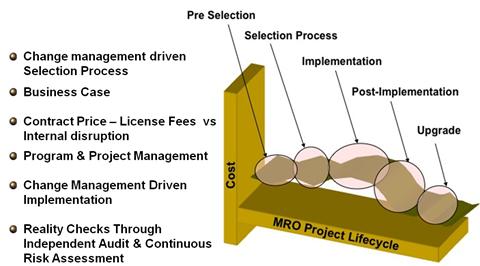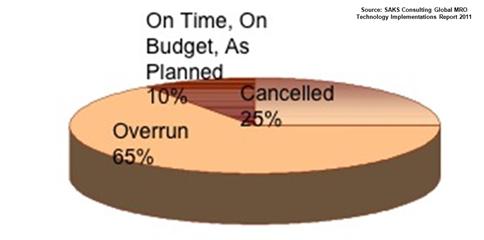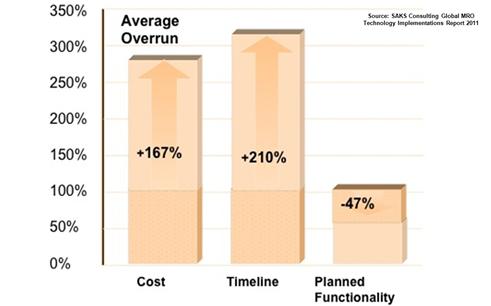Articles
| Name | Author | |
|---|---|---|
| White Paper: What’s up with Aviation IT? | Paul Saunders, Director, Conduce Consulting | View article |
| Case Study: Can airlines pull IT all together? | Vishok Mansingh, Asst. Vice President-Eng Logistics & Systems, Kingfisher Airlines Ltd | View article |
| Case Study: Aircraft Maintenance Management and Control Software Systems do not require long implementation schedules | Aer. Eng. Gustavo Daneri, Maintenance Director, Sol Lineas Aereas | View article |
| Case Study: BoB and ERP: Working together, IT works | Fernando Moura de Lucena, Manager Business Solutions IT, VRG Airlines (Gol Group) | View article |
| White Paper: Are you ready for an Enterprise Wide MRO System? | Sharhabeel Lone, Partner Global Business Strategy, SAKS Consulting | View article |
White Paper: Are you ready for an Enterprise Wide MRO System?
Author: Sharhabeel Lone, Partner Global Business Strategy, SAKS Consulting
SubscribeAre you ready for an Enterprise Wide MRO System?
From hubris to failed implementations, Sharhabeel Lone, Partner Global Business Strategy at SAKS Consulting maps the likely challenges when selecting and implementing an MRO solution
“Judge a man not by his answers, but by his questions.” Those were the words of French philosopher, Voltaire more than 300 years ago. Over the past 15 years of implementing enterpris
e wide MRO (maintenance, repair and operation) systems, Voltaire’s comment has been perhaps the bulwark of assessing whether or not C-level executives, MRO senior management and their teams are headed towards a successful implementation. Typically, ‘What is the best solution out there?’ and ‘how much will this cost?’ are some of the first questions: whereas, the initial questions that should really be asked are, ‘Are we ready to do this?’ and ‘What is our primary driver?’
When asked recently how he felt at the end of a multi-year MRO technology implementation, a C-level executive replied, ‘We’ve just gone through open heart surgery’. And, just like heart surgery, the costs of the procedure for you as a sick patient are not the most important questions. The important questions are, ‘Do I have the right experienced medical team?’ ‘Are the operating room and support staff ready?’ and, ‘Are they equipped to carry out this procedure?’
Almost two decades ago, when asked to provide thought leadership, we were occasionally heckled when we spoke of a fast approaching time when Airline MRO organizations would have to prepare for an independent future because they would no longer be seen as part of an airline’s core business: a time they would be spun off as separate businesses competing head-on with pure play MROs. Today, again, we find ourselves predicting yet another inflection point, amid increasingly challenging times for the MRO industry, where we see new aircraft types, increased data requirements and a reticence of airlines and pure play MROs to accept current MRO cost structures.
We see MRO business models in the future moving from becoming independent businesses to highly competitive cross-border consolidated entities. Securing that future requires technology backbones that can not only enable best practices in a fully compliant manner but ones that are fully integrated: able to plug and play new technologies handling the requirements for ever more sophisticated data provisioning whilst providing real time enterprise wide visibility.
So why is it that MRO organizations are generally so poor at enterprise wide technology implementations: or, for that matter, at implementing most technology projects? In many cases it’s plain old hubris mixed with a lack of commitment from the business. How difficult can it be to do a selection, right?
With decades of successful experience of the initial provisioning of billion dollar fleets, the ability to solve complex engineering problems in little time, planning for the servicing of multiple fleets without disrupting the network, regularly stripping down and building back up half a million disparate parts and boasting inventories ranging from the millions to the hundreds of millions of dollars; ‘How difficult can it be to put in a computer system for you IT folks?’. Voltaire would not have been happy with that last question. These are business led programs and not IT led ones. No matter how many times this is said, it rarely sinks in to the depth required within most organizations.
MRO organizations across the world are embarking ever more aggressively on the thorny path of enterprise wide technology implementations. Europe, which started at the bleeding edge a decade ago, bears the deep scars of such programs. Asia came next and North America has just reached the start of the curve. From SARS to 9-11 to the global financial crisis there have been many reasons to put off programs like this.
MRO Program Lifecycle:

©SAKS Consulting 2011
Those that have gone through the ‘looking glass’ of implementations and come back out have almost put such implementations behind them and are looking to newer value added technologies that they can ‘plug’ into their shiny new technology backbones. The naysayers and fence sitters have busied themselves during this period by sticking increasing numbers of plasters over the ever widening cracks that are leaking compliance related issues from their tired legacy systems. The hope seems to be that, as they have happily muddled through for 20 years, perhaps they can do the same for a ‘little’ longer. The ‘little’ is undefined but the realisation fast dawning that it may have already passed.
What we’ve learnt from this past decade of global MRO technology implementations is that the crux of success lies at the selection stage. Yet it isn’t as much about selecting an actual vendor as it is about how thoroughly an organization prepares itself during this stage to avoid the pitfalls for the grinding and very difficult task ahead, that of implementation.
Unfulfilled Expectations:

©SAKS Consulting 2011
A few statistics from our recent 2011 survey of global MRO implementations tells a sordid tale of a lack of this understanding at the outset of these programs. As a result, average cost overruns of up to 250% are not uncommon. Programs that run up to three times the expected timelines whilst delivering only half the expected functionality make up the carcasses of failed or underwhelming implementations. Only 10% claim that they were on time and on budget within their designated factors of error.
On Time, On Budget, As Planned…

©SAKS Consulting 2011
On the plus side we have recently come across aggressive and revitalized heads (EVPs, SVPs, VPs) of MRO organizations looking to put in leading edge enterprise wide technology systems ‘yesterday’. However we have also found that they can be shot down by cautious CIOs who know that any large enterprise wide failure would ultimately be laid at their door. They have also been shot down by CFOs who remain unconvinced of the hypothetical NPV (net present value) driven business cases and forecasted glittering ROI (return on investment) figures; in most cases rightly so.
These frustrated heads of maintenance, tasked with moving old world organizations into the new world are justified to quote the African proverb: ‘I pointed to the moon and the stars and all the glory of the heavens above, but all you saw was the end of my finger.’ However, sometimes their own limited understanding of such mega implementations is partly to blame. Furthermore, an historical less than stellar record of delivery of technology implementations and other change initiatives in most MRO environments plays a critical part in the widespread anxiety at the C-level to sign off on what are typically hefty implementation budgets.
And so we see a common cycle of procrastination which includes costly and often unhelpful department specific mini-projects and enterprise wide selection projects. Many are initiated by MRO organizations either to pacify disgruntled middle managers who have been promised change for a long time. Some to allow a little ‘play time’ to senior managers whose hands are tied behind their back due to the limitations of current systems and who have to figure out ways of meeting ever more oppressive KPIs (key performance indicators). Some projects are undertaken for little more purpose than to give a semblance that something is being done.
At times we have found the same vendor selected three times in three different selection exercises over as many or more years, but the decision-making at the executive board then wavering. For a few, at different levels in the organization, we find relief and hope that by the time a non-decision has been ‘made’ at the executive level, the key players involved in the project will have moved on to other things or different roles in the organization. The reasons stem from fear of change, to the belief that the organization can’t handle the required amount of change to a highly politicized landscape that spells the death knell of such large projects no matter what the reasoning, though we sometimes find some of this devolves into camps of opposing choices of vendor.
Today, many tier one and tier two MROs find themselves at a bottleneck, with inadequate and disparate legacy systems, and a technology environment that, in the main, has been neglected for far too long: a situation as unacceptable as it is unsustainable. In our opinion, the concentration on ROI for MRO technology implementation business cases is no longer among the top three drivers. When we present business cases to global corporate boards, and this has been particularly the basis of our presentations over the last three years, the number one driver and justification element is regulatory compliance.
With the level of underinvestment in both strategy and enterprise wide technologies in many MRO environments over the last few decades, the focus on ROI is a misnomer. These are mammoth change projects that the board must accept have to be done. They must be identified as the number one priority for a CEO of either an airline (not just the EVP/SVP/VP of maintenance) or the CEO of a pure play MRO. Only then will the discussion at board level be focused entirely on ‘what do we need to do to ensure a successful implementation’.
Vendors or systems integrators making their play through talk about short term ROI and low hanging fruit who’s harvesting will somehow miraculously fund these complex implementations should be gently shown the door. No matter how brilliant the studies and potential inventory savings, the offset change management, data cleansing and integration costs alone will dwarf any up front savings that may theoretically be achieved. A healthy understanding of reality and knowledge from past global MRO implementations, in an industry that is both incestuous and, from our experience, happy to share lessons learned, should be important components in the toolkit of MRO selection teams.
Particularly with regards to realistic timelines, these mega implementations are as much about the MRO organizations’ ability to handle the upcoming change as about the vendor or SI’s (systems integrator’s) ability to meet milestones. The expectations of unrealistic timelines has derailed many a project both from a budgeting perspective as well as losing, often completely and crucially, the executive commitment of the board.
That is not to say an ROI is not possible. If the implementation has exceptional executive commitment throughout its lifecycle, is managed (with the focus here on program, project and change management) and executed well, the savings from implementation of best practice processes enabled by the new technologies can, over the medium to long term, deliver significant ROI. The caveated challenges above are traditionally the primary problem areas of such implementations. Hence walking through the ‘looking glass’ presents a myriad of challenges that typically most MRO organizations are neither well prepared for nor, is there often the appropriate mechanism to get help before things turn ugly. The effort the implementation will require is almost always underestimated. Moreover, the extent to which the original goals are met during the project is heavily influenced not necessarily by the degree of freedom the vendor solution will or will not allow but to the discipline to which the MRO organization is willing to adhere. A strategy based on outsourcing organizational problems to systems integrators only results in further problems, not solutions and not workable penalties.
From unstructured selection processes that are not change management driven, shutting out the vast majority of tomorrow’s users, to a lack of transparency that has organizations constantly second guessing selection decisions. From a lack of understanding of the need for several iterations of the cross process visibility of the current MRO business to signed contracts that demonstrate little knowledge of what MRO organizations are buying from vendors and systems integrators. From unnecessarily large implementation teams to poor understanding of data cleansing effort. And from consulting teams that have insufficient MRO knowledge to the lack of formal independent audit. All of these and more form the basis of the real reasons underlying many a failed MRO implementation.
Enterprise wide MRO solutions have changed the face of our industry, transforming the enterprise by applying best business practices and integrating core business processes to improve responsiveness, competitiveness and profitability. The challenges must be understood, approached with open eyes, grasped with both hands and sleeves rolled up. Taming these ‘implementation beasts’ is as much an art as it is a science.
Comments (0)
There are currently no comments about this article.

To post a comment, please login or subscribe.